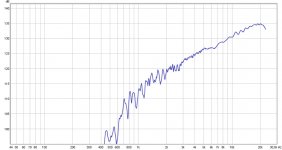Anyone know at witch frequency charge migration comes to play ?
lets say i use metalized mylar.... hold your horses!!!! for a panel lets say playing from 500 hz ? would that be a problem at that frequency ? i cant seem to find an clear answer, i know it will result in distortion down low... but how low ?
lets say i use metalized mylar.... hold your horses!!!! for a panel lets say playing from 500 hz ? would that be a problem at that frequency ? i cant seem to find an clear answer, i know it will result in distortion down low... but how low ?
There are two mechanisms for charge migration.Anyone know at witch frequency charge migration comes to play ?
lets say i use metalized mylar.... hold your horses!!!! for a panel lets say playing from 500 hz ? would that be a problem at that frequency ? i cant seem to find an clear answer, i know it will result in distortion down low... but how low ?
1) Migration of charge between the HV supply and the diaphragm
Assuming you are using high value charging resistor between your HV supply and diaphragm, the speed of charge migration on/off the diaphragm is limited by the RC time constant (R = charging resistor, C = stator-diaphragm capacitance). For example, if R=10Meg and C = 200pF, then F = 1/RC = 500Hz. So below 500Hz, charge migration will become progressively more of a problem, and above 500Hz it will become progressively less of a problem.
2) Migration of charge already on the diaphragm to areas of the diaphragm that are closer to a stator
This is mainly an issue at lower frequencies where resonance modes develop on the diaphragm and diaphragm excursion is a significant percentage of the gap. In particular, at fundamental resonance charge rushes to the center of the diaphragm due to the catenary shape of the diaphragm excursion resulting in 3rd harmonic distortion. No amount of resistance between HV supply and diaphragm will keep this from happening…you need to use a high resistance coating.
Thanks Bolserst i hoped you would chip in 🙂 haha. so yeah if i keep resonance lower then the used band, and use a high resistor on the output on the HV i should be no problem.... or at least not that big haha
thanks !, might be making some verry narrow tweeters. and with the paper posted earlier, and the measurement i had once with the use of conductive fabric i hope i can get a clean ouput from 800-1000 to 20khz as tweeter only
thanks !, might be making some verry narrow tweeters. and with the paper posted earlier, and the measurement i had once with the use of conductive fabric i hope i can get a clean ouput from 800-1000 to 20khz as tweeter only
Pretty much 🙂...so yeah if i keep resonance lower then the used band, and use a high resistor on the output on the HV i should be no problem.... or at least not that big
Of course, always be careful using metalized mylar with un-insulated stators.
It can/will catch fire.
Pretty much 🙂
Of course, always be careful using metalized mylar with un-insulated stators.
It can/will catch fire.
🙂 hmm yeah good point !, well might go for coating then anyways 🙂
Oh yeah! Forgot about that…here it is:like this one i remember you said it was rather straigh (well beside the roll, of of course 😉)
I cant reach above 15Khz on my planars
Oh yeah! Forgot about that…here it is:
I cant reach above 15Khz on my planars
nice i was looking for the measurement that i posted few posts later for a while haha 🙂 now i accidently find it since you post an older post of mine haha ThX m8 !
- Status
- Not open for further replies.
- Home
- Loudspeakers
- Planars & Exotics
- Anyone know at witch frequency charge migration comes to play ?
